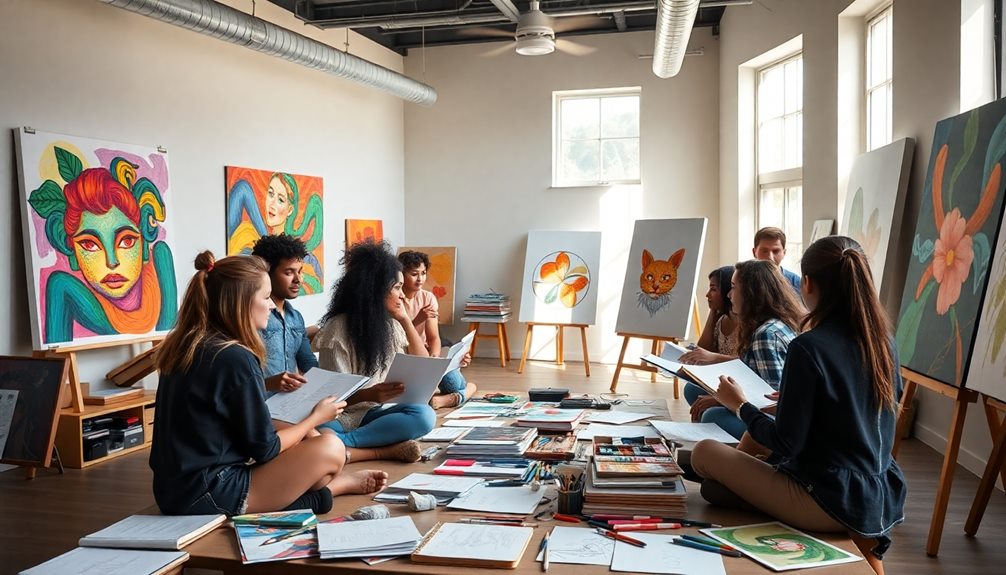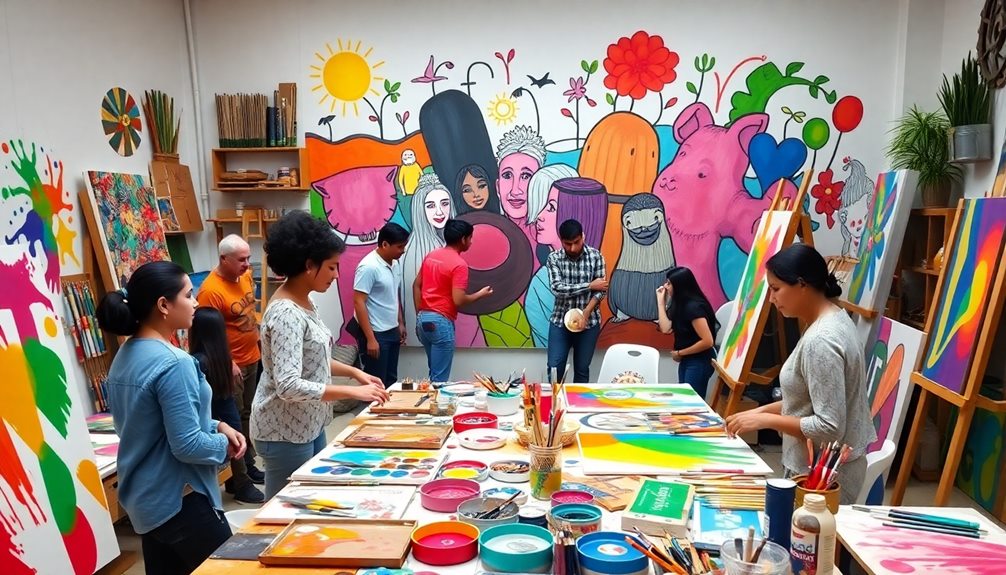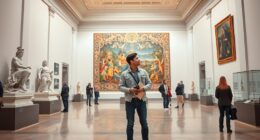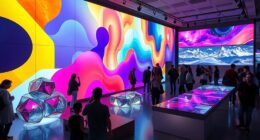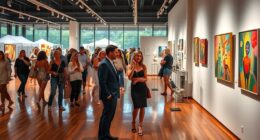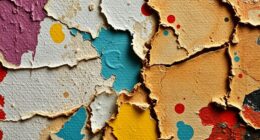Art history research methods combine various analytical approaches to help you understand artworks deeply. You'll explore formalism, which focuses on visual elements, and contextual interpretation, which considers historical and cultural backgrounds. Theoretical frameworks, such as feminism and psychoanalysis, enhance your insight into themes and meanings. It's also essential to gather resources like scholarly articles and bibliographies for a comprehensive analysis. By employing these methods, you'll develop critical thinking skills to articulate your findings effectively. To uncover more about navigating these approaches, you can explore the unique frameworks and practical tips that await your curiosity.
Key Takeaways
- Art history research employs various methodologies, including formalism, iconography, and contextual interpretations to analyze artworks comprehensively.
- Understanding the historical and cultural context surrounding art is crucial for accurate analysis and interpretation.
- Diverse theoretical frameworks, such as feminism and psychoanalysis, enhance engagement with themes and societal implications in art.
- Utilizing resources like OneSearch, JSTOR, and bibliographies is essential for gathering scholarly materials and enriching research.
- Ethical considerations, including cultural heritage and provenance, are vital in ensuring responsible engagement with artworks and their histories.
Introduction
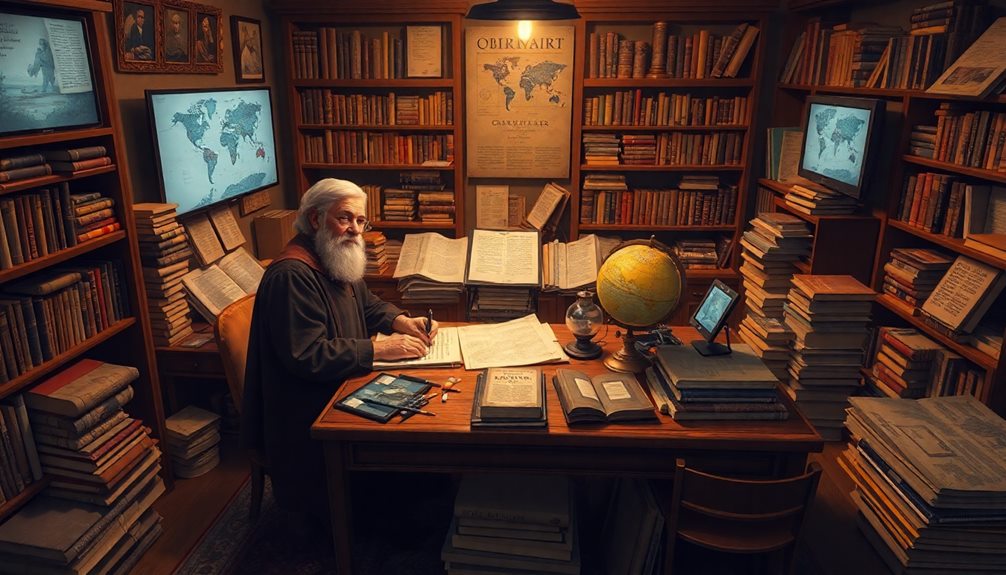
Art history research methods involve a range of approaches that help you dive deeper into the meaning and context of artworks. As you explore art history, you'll encounter various methodologies, including formalism, iconography, and contextual interpretations.
These methods enable you to analyze key visual elements like color, line, and composition, while situating artworks within their historical, cultural, and social frameworks. Engaging with these methodologies is akin to the philosophical exploration that encourages deeper self-reflection, as seen in philosophical insights.
Art historians utilize these diverse methods to enhance their understanding of art across different periods and styles. This comprehensive analysis goes beyond mere aesthetics; it also considers the artist's intentions and how audiences have received these works over time.
By engaging with key theoretical perspectives such as feminism, psychoanalysis, and postcolonialism, you can gain valuable insights into the societal implications of art.
Mastering these research methods is crucial for developing your critical thinking skills. They'll empower you to articulate thoughtful insights about visual culture and artistic expression.
As you delve into the rich tapestry of art history, these methodologies will serve as essential tools in your quest to understand and appreciate the complexities of art and its enduring impact on society.
Key Concepts and Definitions
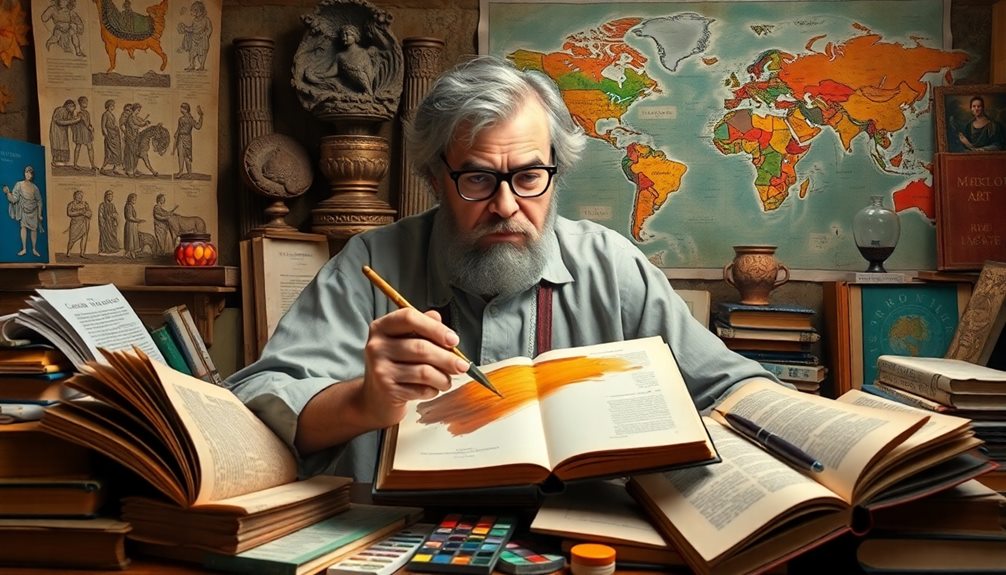
Understanding key concepts and definitions in art history research methods is essential for effective analysis. You'll encounter various methodologies, each providing distinct lenses through which to view art and art.
Formalist, for instance, emphasizes visual elements like color, line, shape, and texture, directing your focus to the aesthetic experience independent of contextual influences. In the digital age, igniting creativity can be challenging, as nurturing an imaginative mindset is crucial for artists and researchers alike.
In contrast, contextual interpretations dive into the historical and cultural backgrounds of artworks, enriching your understanding of their significance.
Marxist art analysis specifically examines the relationship between art and socio-economic conditions, highlighting how class struggles and power dynamics shape artistic expression. This perspective can uncover the underlying messages within a piece, revealing how it reflects or critiques societal norms.
Other methodologies, like feminism and psychoanalysis, add further depth, allowing you to explore themes of gender and subconscious influences on artistic creativity.
Ultimately, familiarizing yourself with these key concepts will empower you to engage with artworks more critically and insightfully, enhancing your appreciation of the complex interplay between culture, society, and artistic production.
Research Framework Essentials
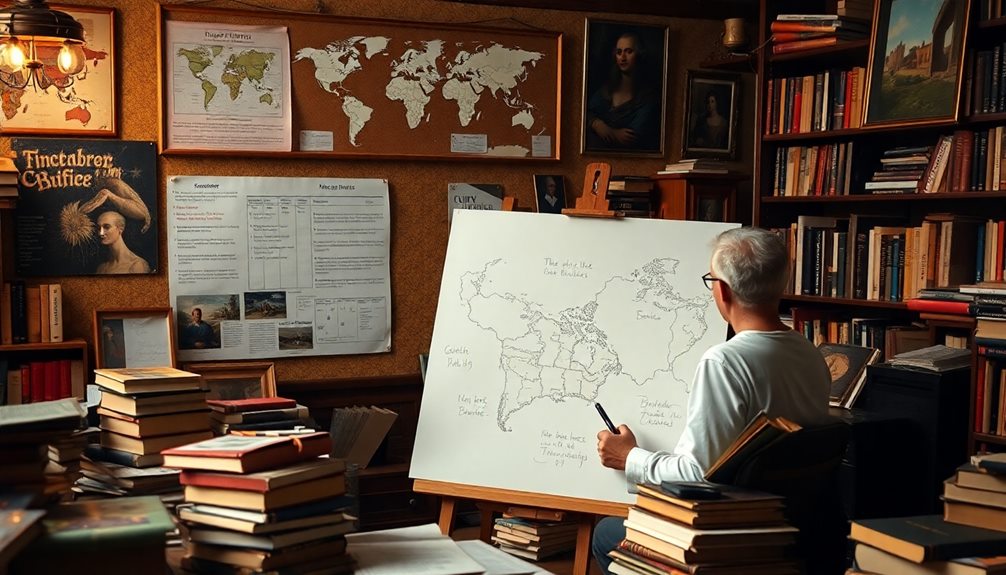
When diving into art history research, a solid framework is crucial for effective analysis and interpretation. Start by establishing a clear understanding of the historical and cultural context surrounding the artwork. This foundational knowledge lays the groundwork for deeper insight.
Utilize diverse methodologies, such as formalism, iconography, and critical theory, to analyze art by analyzing how different elements influence meaning. Incorporating high-quality content not only enhances your analysis but also boosts the credibility of your findings.
Incorporate visual analysis, contextual inquiry, and theoretical frameworks to create a comprehensive critique. This approach allows you to describe, analyze, interpret, and evaluate artworks within their respective societal structures. Remember, the way you approach research not only redefines meanings but also shapes how art is perceived and understood.
To enhance your capabilities, tap into comprehensive bibliographies, academic databases, and interlibrary loan services. These resources give you access to a wide array of sources and perspectives on specific art objects or movements.
Real-world Art Analysis

Analyzing real-world art requires a systematic approach that combines description, analysis, interpretation, and evaluation. This method allows you to grasp the artwork's significance and context fully.
Start by utilizing methodologies like formalism, iconography, and psychoanalysis to explore various elements and themes. These approaches can reveal the artist's subconscious influences and the depth of the work.
Contextual factors are also crucial. Consider the artist's biography, historical background, and the socio-political environment at the time of creation. This understanding will lead to a more nuanced interpretation of the artwork.
You might also engage in comparative analysis by examining similar works or styles. This not only enhances your understanding of the artist's unique approach but also situates their work within broader art movements.
Tips and Best Practices

Starting your art history research with a solid foundation is crucial for success. Begin by building your knowledge of the artwork or artist through museum websites and bibliographies. This initial context will guide your exploration of the broader narrative, particularly regarding women in art.
Next, utilize OneSearch and WorldCat to efficiently gather books and articles from various institutions, ensuring a well-rounded collection of resources.
When analyzing artwork, don't shy away from employing diverse methodologies. Formalism, iconography, and psychoanalysis can provide multiple perspectives and deepen your understanding. As you compile information, document all your sources accurately. Tools like RefWorks, EndNote, or Zotero can help you organize your references and maintain academic integrity.
Lastly, engage with recent historiography and scholarly debates to grasp evolving interpretations within art history. Understanding these discussions is essential, especially when considering the importance of inclusivity.
Audience Engagement Insights
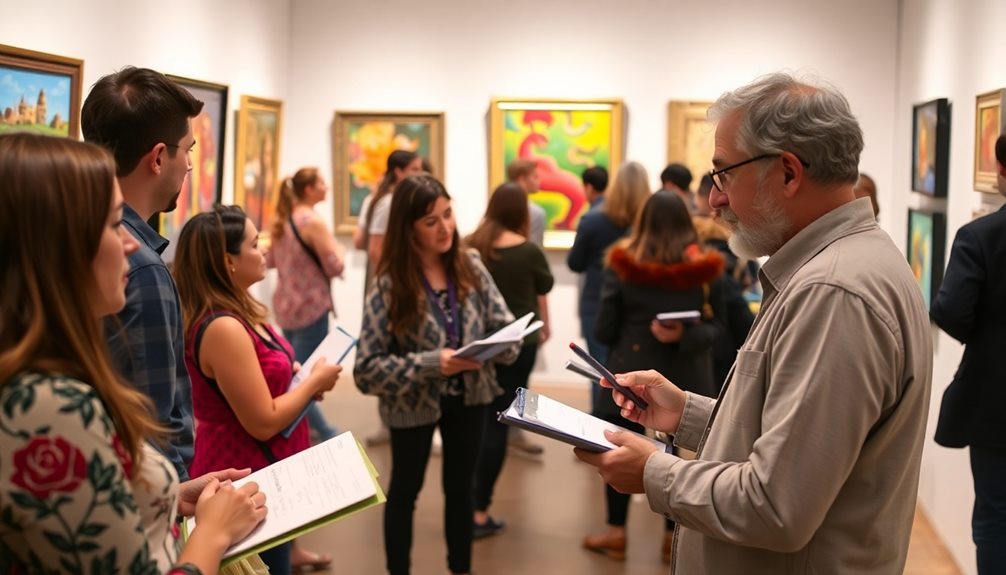
Engagement in art history transforms how audiences appreciate and connect with artworks. By incorporating interactive elements like guided tours or digital platforms, you can encourage deeper exploration of both the pieces themselves and their historical contexts.
Storytelling techniques can also play a vital role; when you present historical narratives in a relatable way, it helps create personal connections to the artists and their works, making the experience more memorable.
Audience engagement doesn't end with presentations. Gathering feedback from visitors is crucial in shaping art history exhibitions. Understanding preferences and interests allows you to create displays that resonate more powerfully with the audience.
In today's digital age, leveraging social media and online communities can spark discussions on art historical topics, expanding your reach beyond traditional academic environments.
Ethical Dilemmas in Art Research
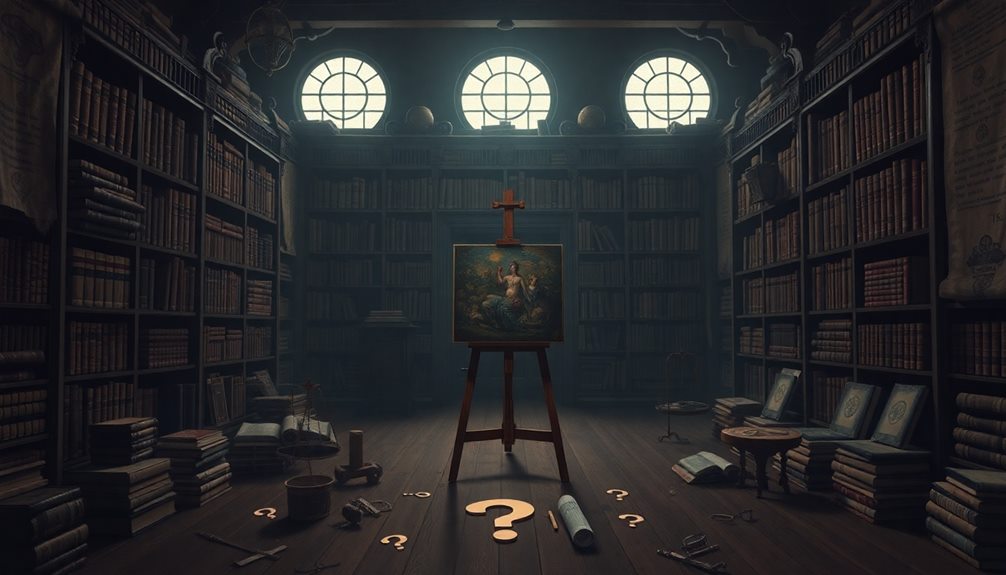
Navigating ethical dilemmas in art research requires a careful balance of appreciation and respect for cultural heritage.
You'll often encounter issues of cultural appropriation, where the line between celebrating a culture and exploiting it becomes blurred. This demands sensitivity and a deep understanding of the cultural contexts you engage with.
Provenance research is another critical aspect that can reveal unethical practices, such as looting or illegal acquisition of artworks. You need to verify the ownership history diligently, especially in post-colonial contexts, to uphold the integrity of your research.
Conflicts of interest may arise when collaborating with institutions or collectors, particularly if financial incentives threaten your objectivity.
Moreover, you must consider the treatment of living artists and their families. Obtaining consent for using their work is essential, as is being mindful of how commercialization might impact them.
Transparency in your methodology and responsible citation of sources play vital roles in avoiding misinformation. Upholding these principles not only fosters trust within the academic community but also enhances the ethical foundation of your work in art research.
Additional Resources

When diving into art history research, having access to a rich array of resources can significantly enhance your understanding and analysis. Start with OneSearch, which allows you to tap into a comprehensive database of books across CUNY schools, making resource gathering efficient.
For a broader range of materials, including rare texts and specialized publications, explore WorldCat.
Don't overlook journal databases like JSTOR and Art Full Text; they provide access to scholarly articles specifically focused on art history, which can deepen your research.
Key texts, such as "Women, Art, and Power" by Linda Nochlin and "Principles of Art History" by Heinrich Wölfflin, are foundational for grasping various methodologies and theories, including post-colonial theory, that inform the visual arts.
Additionally, online tools like Oxford Bibliographies Online offer peer-reviewed annotated bibliographies that guide you through critical literature in art history and related fields.
Utilizing these resources won't only enrich your research but also enhance your analytical skills, enabling you to engage more critically with the complexities of art history.
Frequently Asked Questions
What Are Methods in Art History?
In art history, you explore methods like formalism, contextual analysis, psychological perspectives, and postcolonial critique. Each approach reveals different insights, helping you understand artworks through their visual elements, historical context, and cultural implications.
What Are the 3 History Research Methods?
When you explore history research methods, you'll find three key approaches: formal analysis, which breaks down visual elements; contextual analysis, focusing on historical context; and iconographic analysis, interpreting symbols and themes for deeper understanding.
What Are the Art Research Methods?
When exploring art research methods, you'll encounter formalism, iconography, Marxism, and feminism. Each reveals different insights into artworks, helping you understand their visual elements, symbols, societal context, and gender representations more deeply.
How to Do Research in Art History?
To research art history, start by gathering foundational knowledge from museum websites. Use OneSearch for book searches, explore journal databases for scholarly articles, and always collect more sources than required for a comprehensive understanding.
Conclusion
In conclusion, diving into art history research can be both rewarding and challenging. By grasping key concepts, employing effective research frameworks, and applying practical analysis, you'll enhance your understanding of art's rich narrative. Remember to engage your audience and navigate ethical considerations thoughtfully. With these tools and insights, you're well-equipped to explore the fascinating world of art history and contribute meaningfully to the field. Embrace the journey and let your curiosity guide you!


